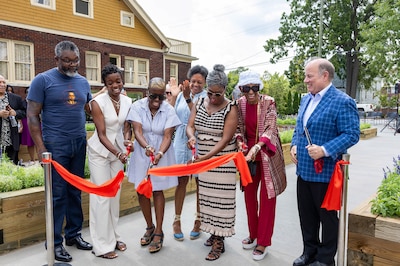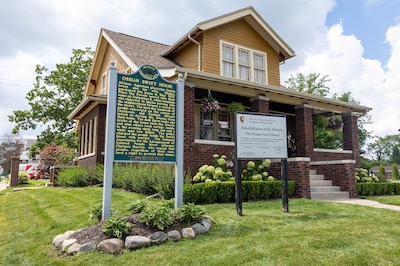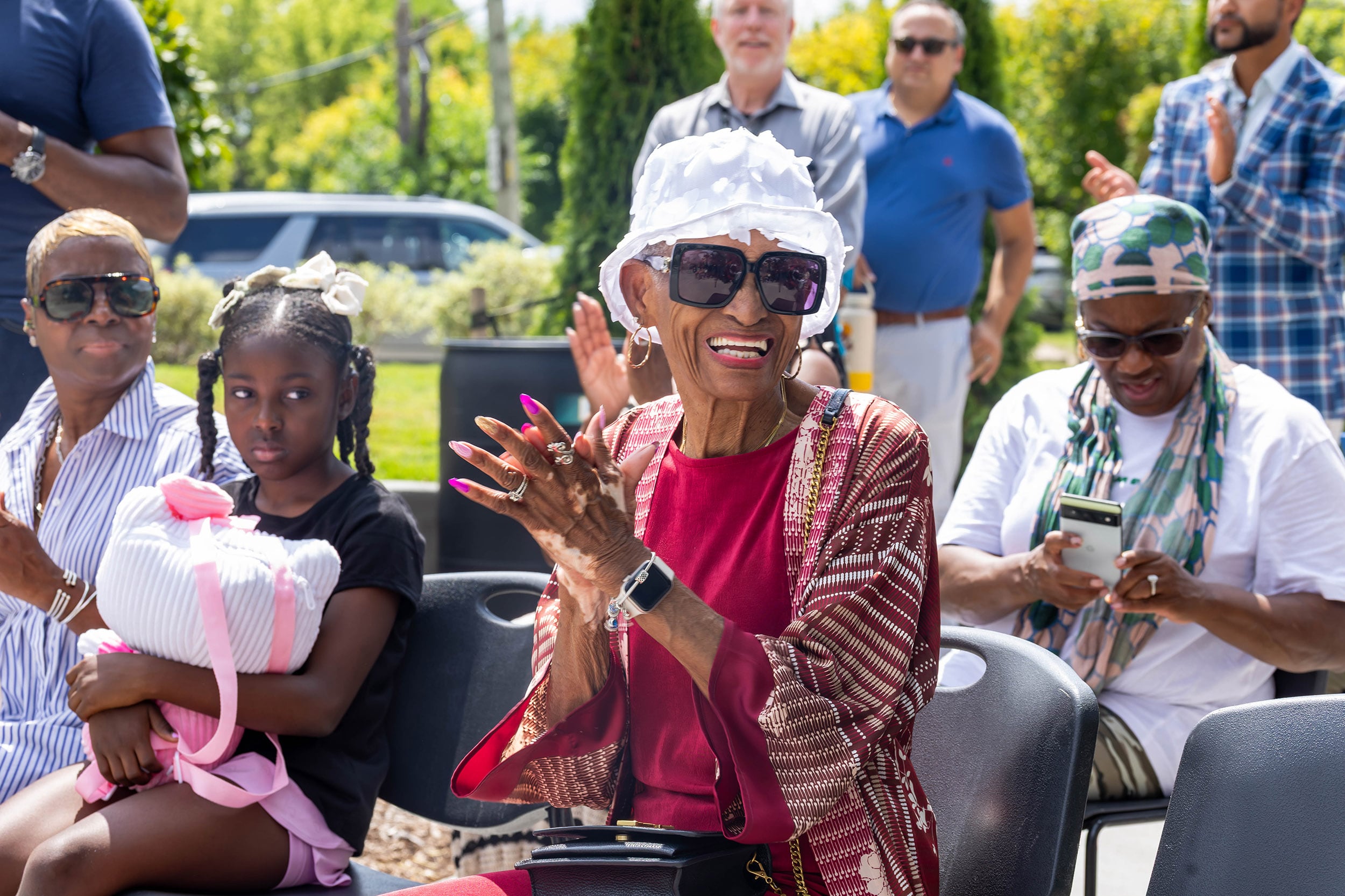Sign up for Chalkbeat Detroit’s free newsletter to keep up with the city’s public school system and Michigan education policy.
Almost 100 years after a Black physician and his family faced a horrific racial attack outside their home on Detroit’s east side, the city unveiled an educational park to honor his legacy.
Mayor Mike Duggan, the city’s General Services Department and community members gathered outside the former house of Dr. Ossian Sweet Wednesday for a ceremony celebrating a park with his namesake.
Located next door to Sweet’s former home at 2921 Garland Street, the Dr. Ossian Sweet Memorial Park features wooden planters filled with lavender, installations detailing the history of Sweet and his family, and 11 memorial trees to honor the people who were in the house during the 1925 attack: Sweet, his wife, Gladys Sweet, Sweet’s two brothers, and seven friends.
“The history isn’t something we’re proud of, but the way we remember where we’ve come from and where we are now is really important,” Duggan said Wednesday at the ceremony.
Two elm trees planted at the park entrance are dedicated to Sweet and his wife, and an oak tree in the center of the park honors their daughter Iva, who was a few months old when the event took place. Iva later died from tuberculosis at age 2.
Duggan said when he became mayor in 2013, Garland Street had deteriorated. That’s when he and the department came up with the idea for a memorial. Development began in 2022, with the support of $1 million in pandemic relief funds.

“There’s an opportunity for historic tourism in this city, and we have some great history to tell,” Duggan said.“We are going to make sure that the corner of Charlevoix and Garland is going to be one of those destinations.”
Along with the park, the city’s Housing and Revitalization Department is working to renovate three vacant homes across from the Ossian Sweet House, as well as one flanking the opposite end of the park — all are being restored to match the 1925 style.
Sweet moved his family into the house on the corner of Charlevoix and Garland in September 1925, when the area of the city was all white because of redlining practices and pervasive racial discrimination in housing. During the Sweets’ first evening in their new home, a white mob of about 400 gathered on the corner to intimidate Sweet and his family, screaming and throwing rocks at the house. As the Sweets tried to defend themselves, shots were fired at the mob from inside the house; one white man was killed and another was injured. Sweet and his brother were arrested and taken to jail.

In 1926, Sweet and the others inside the house were acquitted of murder in a landmark court case that paved the way for many advances in equal criminal justice for Black Americans.
Sweet moved back into the Garland Street house in 1928, where he lived until he sold the house in 1958. He died in 1960.
Duggan said during Wednesday’s ceremony that he studied Sweet’s case while he was a student at the University of Michigan Law School. As Wayne County prosecutor in the early 2000s, Duggan fought to have a Michigan historical marker placed at the house, which happened in 2004.
“You can actually go in, sit in that upstairs window and look out and imagine the mob that that family saw 100 years ago, knowing all the police officers down there weren’t doing anything to protect you,” he said. “There was no protection but themselves. And you can experience what that family went through and how much they’ve helped.”
Keeping history alive
The current owner of the Sweet House is Daniel Baxter, chief of operations for Detroit’s Department of Elections, who consulted for the city’s elections office in 2020, when a predominantly white mob stormed the Huntington Center as votes in the presidential election were being counted. Baxter’s family has owned the house since 1958 after Sweet moved out.
Baxter has known about the history of his house since he was a child. At the ceremony, Baxter recalled a time when a reporter came by the house in 1975 to talk about Sweet and the attack. His parents did not want to talk to the reporter, but 10-year-old Baxter did. When the article came out the next day in the paper, his school teacher asked him to tell Sweet’s story to his classmates.
“That day when I came back home, I said to my mother, ‘I want to learn more about the man who lived in this house,’” Baxter said. “She went into the pantry, grabbed a banker’s bag with a treasure of articles on Dr. Sweet.”
In 2021, Baxter and his family produced a documentary about Sweet.
“We have the opportunity to be enriched by the history and the legacy and resilience of Dr. Ossian Sweet,” he said.
The home was named to the National Registry of Historic Places by the U.S. Department of the Interior in 1985 and, in 2018, the African American Civil Rights program of the Historic Preservation Fund at the National Park Service gave the city a $500,000 grant to rehab and repair Sweet’s house, which had fallen into disrepair.
Baxter founded the Ossian H. Sweet Foundation, which operates the home. The restoration project was recently completed so that the house can serve as a public museum.
Sweet’s niece, Jacqueline Spotts, 83, told BridgeDetroit Wednesday that she remembers her uncle always teaching her about Black history and civil rights.
But she only learned about the attack after reading about it in a newspaper as an adult. With the attack being a “scar on the family” for a long time, Spotts is happy to see the city recognize her uncle with the park.
“It’s wonderful, and God has allowed me to see it,” she said.
Annie Marshall and her granddaughter also attended the ceremony. She’s lived in a home down the street on Garland since she was 8 years old. Now 75, Marshall remembers visiting the Baxters during the 1960s and hanging out with the family during block parties and other events.
She found out about Sweet in high school, and she said she is glad to see the park and the city’s plans to renovate the four houses nearby. She said the neighborhood has faced ups and downs over the years, and she’s starting to see people move back in on the block.
“I think he (Sweet) would be proud of the street now,” Marshall said.






